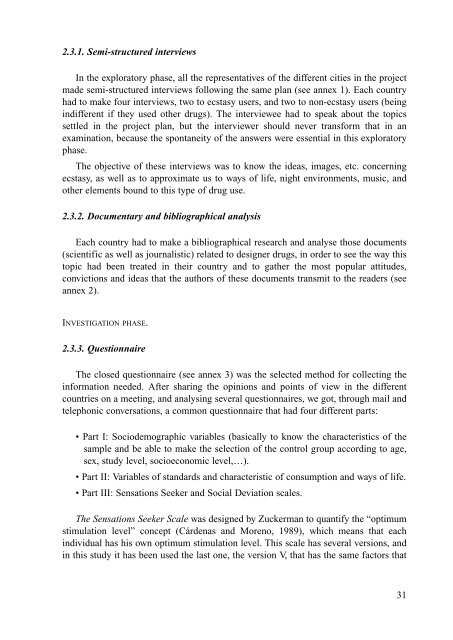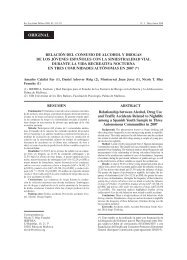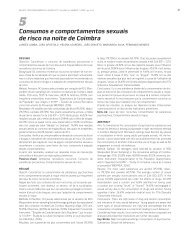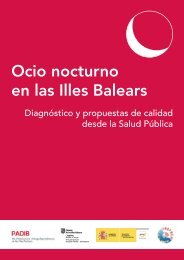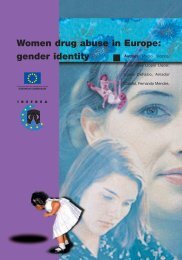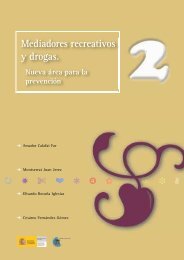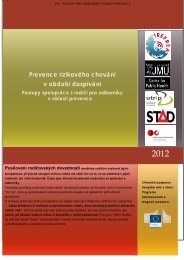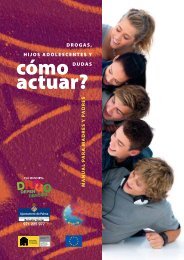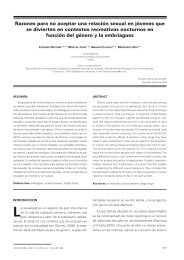Characteristics and social representation of ecstasy in Europe - Irefrea
Characteristics and social representation of ecstasy in Europe - Irefrea
Characteristics and social representation of ecstasy in Europe - Irefrea
Create successful ePaper yourself
Turn your PDF publications into a flip-book with our unique Google optimized e-Paper software.
2.3.1. Semi-structured <strong>in</strong>terviewsIn the exploratory phase, all the representatives <strong>of</strong> the different cities <strong>in</strong> the projectmade semi-structured <strong>in</strong>terviews follow<strong>in</strong>g the same plan (see annex 1). Each countryhad to make four <strong>in</strong>terviews, two to <strong>ecstasy</strong> users, <strong>and</strong> two to non-<strong>ecstasy</strong> users (be<strong>in</strong>g<strong>in</strong>different if they used other drugs). The <strong>in</strong>terviewee had to speak about the topicssettled <strong>in</strong> the project plan, but the <strong>in</strong>terviewer should never transform that <strong>in</strong> anexam<strong>in</strong>ation, because the spontaneity <strong>of</strong> the answers were essential <strong>in</strong> this exploratoryphase.The objective <strong>of</strong> these <strong>in</strong>terviews was to know the ideas, images, etc. concern<strong>in</strong>g<strong>ecstasy</strong>, as well as to approximate us to ways <strong>of</strong> life, night environments, music, <strong>and</strong>other elements bound to this type <strong>of</strong> drug use.2.3.2. Documentary <strong>and</strong> bibliographical analysisEach country had to make a bibliographical research <strong>and</strong> analyse those documents(scientific as well as journalistic) related to designer drugs, <strong>in</strong> order to see the way thistopic had been treated <strong>in</strong> their country <strong>and</strong> to gather the most popular attitudes,convictions <strong>and</strong> ideas that the authors <strong>of</strong> these documents transmit to the readers (seeannex 2).INVESTIGATION PHASE.2.3.3. QuestionnaireThe closed questionnaire (see annex 3) was the selected method for collect<strong>in</strong>g the<strong>in</strong>formation needed. After shar<strong>in</strong>g the op<strong>in</strong>ions <strong>and</strong> po<strong>in</strong>ts <strong>of</strong> view <strong>in</strong> the differentcountries on a meet<strong>in</strong>g, <strong>and</strong> analys<strong>in</strong>g several questionnaires, we got, through mail <strong>and</strong>telephonic conversations, a common questionnaire that had four different parts:• Part I: Sociodemographic variables (basically to know the characteristics <strong>of</strong> thesample <strong>and</strong> be able to make the selection <strong>of</strong> the control group accord<strong>in</strong>g to age,sex, study level, socioeconomic level,…).• Part II: Variables <strong>of</strong> st<strong>and</strong>ards <strong>and</strong> characteristic <strong>of</strong> consumption <strong>and</strong> ways <strong>of</strong> life.• Part III: Sensations Seeker <strong>and</strong> Social Deviation scales.The Sensations Seeker Scale was designed by Zuckerman to quantify the “optimumstimulation level” concept (Cárdenas <strong>and</strong> Moreno, 1989), which means that each<strong>in</strong>dividual has his own optimum stimulation level. This scale has several versions, <strong>and</strong><strong>in</strong> this study it has been used the last one, the version V, that has the same factors that31


